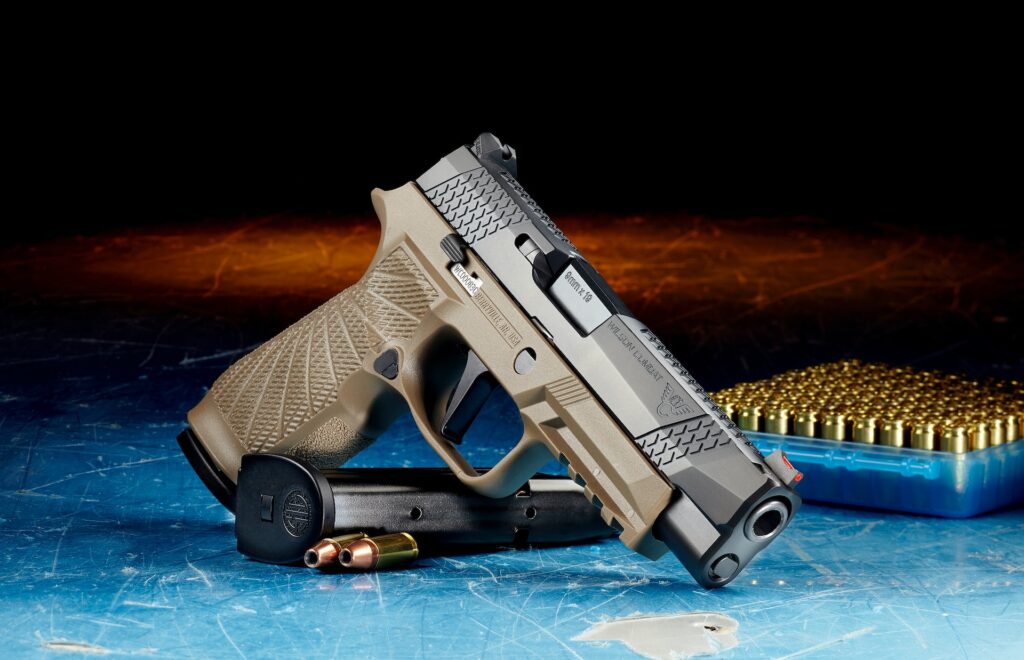Harshvardhan Singh works as a Senior Service Engineer at a mining firm in India. He is currently working into oil analysis field. Has worked in the filed of tribology and lubrication and loves to write about the same.
Firearm Lubrication
Table of Contents
Introduction
A gun is a device or ranged weapon that utilizes pressure or explosive force to propel a projectile. It is designed to launch projectiles with accuracy and force. While guns come in various forms and sizes, the principles of their operation remain consistent.
The introduction of guns marks a significant turning point in the history of warfare, technology, and human civilization. The development of firearms revolutionized combat and had a profound impact on various aspects of society. Guns being a mechanical device combining several small parts, just like any other system requires maintenance.
Enhancing Gun Performance
By diligently maintaining your firearm and implementing effective cleaning practices, you can significantly enhance its performance in multiple ways.
1. Optimize Accuracy and Precision: Thoroughly clearing your gun of debris, such as dirt, dust, and residue, is crucial to ensure consistent and reliable accuracy. Regularly inspect and clean the barrel, action, ejector, and chamber, as these areas are prone to accumulating contaminants. A clean gun reduces the chances of any obstruction affecting the trajectory of the bullet, resulting in improved accuracy and precision.
2. Enhance Firing Speed: Alongside debris, fouling caused by copper, plastic, lead, and powder residue can accumulate within the barrel and other critical components. This buildup can negatively impact the firearm’s performance, leading to a decrease in firing speed and reliability. Regular cleaning and maintenance, specifically targeting the removal of fouling, helps to maintain optimal performance and consistent firing speeds.
3. Prolong Gun Lifespan: Firearms endure significant stress and wear due to the movement and interaction of metal parts. Proper cleaning and lubrication play a vital role in reducing friction and preventing excessive wear and tear. Regularly applying appropriate lubricants to the moving parts of your gun reduces friction, minimizing stress and the likelihood of failure. This, in turn, extends the lifespan of your firearm, ensuring it remains functional for a longer period.
4. Prevent Corrosion and Rust: Firearms are susceptible to corrosion, especially when exposed to moisture, humidity, or harsh environmental conditions. Cleaning your gun regularly and applying protective coatings or rust inhibitors helps prevent corrosion, preserving the integrity of the metal surfaces. This not only maintains the firearm’s aesthetics but also ensures reliable functionality over time.
5. Safe and Reliable Operation: A well-maintained firearm is less likely to experience malfunctions or misfires, ensuring safe operation. Regular cleaning and maintenance practices help identify potential issues or damaged components that may require professional attention, minimizing the risk of accidents or unreliable performance.
Firearm lubrication points
After you make certain your handgun is unloaded and disassemble your pistol, there are three main areas that need lubrication: the slide, the barrel, and the frame and its parts and mechanisms. Each area with multiple spots to lubricate and spread around the lube. Some typical lubrication manuals that I found on web have been shared below depicting typical lubrication points of certain specific guns. Remember to always follow your manufacturer’s lubrication guidelines and instructions when lubricating your firearm.


Gun oil overview
Gun oil is a specially formulated type of penetrating oil and contains additives designed for use with rifles and pistols. According to United States Patent 7432231, basic gun oil is composed essentially of the ingredients isopropanol, petroleum distillate or heptane, viscosity modifiers, antioxidants and reducing agents.
History of gun oil
The history of gun lubricants is closely tied to the development of firearms themselves. As firearms evolved and became more complex, the need for effective lubrication to ensure reliable operation and longevity of the weapon became apparent. Here’s a brief overview of the history of gun lubricants:
1. Early firearm lubrication: In the early days of firearms, such as during the Renaissance period, simple lubricants like animal fat, tallow, or beeswax were used to reduce friction between moving parts. These substances helped prevent excessive wear and corrosion.
2. Development of mineral oils: With the advent of more sophisticated firearms in the 19th century, mineral oils gained popularity as lubricants. Mineral oils were derived from petroleum and offered better lubricating properties than animal-based lubricants. They were effective in reducing friction and preventing rust and corrosion.
3. Introduction of greases: As firearms continued to advance, greases made their way into gun lubrication. Greases are a mixture of oil and a thickening agent, such as lithium or calcium, which provides enhanced adhesion to surfaces. They are particularly useful for applications where the lubricant needs to stay in place for an extended period or under high pressure.
4. Modern synthetic lubricants: In the mid-20th century, synthetic lubricants started to emerge. These lubricants were chemically engineered to provide specific properties, such as high temperature resistance, superior rust protection, and extended service life. Synthetic lubricants, often based on polyalphaolefin (PAO) or ester compounds, offered improved performance over traditional mineral oils.
5. Specialized gun lubricants: In recent years, gun-specific lubricants have gained popularity. These lubricants are formulated to meet the unique requirements of firearms, including high-pressure and high-temperature environments. They often incorporate additives to enhance performance, such as anti-wear agents, corrosion inhibitors, and extreme pressure additives.
Gun grease
Gun lubricants are of high importance as they help you in keeping your guns efficient and performing. The composition of firearm greases can vary depending on the manufacturer and specific product. Like any other grease the composition of gun grease comprises of base oil, thickener, and additives. Some firearm greases may also contain solid lubricants such as molybdenum disulfide (MoS2) or graphite to enhance their performance under extreme conditions.
Grease is an advantageous product explicitly for those who are hunters and shooters as they have to deal with harsh environments and severe conditions. Cleaning your gun with gun grease gives a layer on the compartments and parts of the gun, which makes sure it stays protected from environmental conditions.
Dry film lubricants for guns
A dry lubricant, also known as a solid film lubricant, uses a dry substance or coating to reduce friction between two surfaces. These types of firearm lubes are often aerosols formulated with molybdenum disulfide, along with acetone, propane and other components. Other dry film lubes come in powder form.
Comparison: Oil V/S Grease V/S Dry film lubes
|
Gun Oil |
Gun Grease |
Dry Film Lubricant |
|
| Composition | Base oil, additives | Base oil, thickener, additives | Solid lubricant particles suspended in a carrier |
| Lubrication Properties | Low viscosity, fluid lubrication | Higher viscosity, better adhesion | Forms a solid lubricant film |
| Application | General lubrication, cleaning | Heavy loads, high temperatures | High-temperature, clean environments |
| Benefits | Easy application, penetrates well | Long-lasting, better resistance to heat | Dry and clean lubrication |
| Drawbacks | Requires frequent reapplication | Thick consistency, can attract dirt | Requires thorough surface preparation |
| Ideal Uses | General firearm lubrication | Slides, rails, gears, heavy load areas | High-temperature, clean environments |
| Examples | CLP (Cleaner, Lubricant, Protectant) | Lithium-based grease, synthetic grease, aluminum based grease |
Molybdenum disulfide (MoS2) coatings, PTFE-based lubricants |
References
Cook, Alan. “Understanding Gun Lubrication.” BuyGreatOil.Com, 21 Nov. 2022,
www.buygreatoil.com/understanding-gun-lubrication/
“Firearm Maintenance.” Wikipedia, 29 May 2023,
https://en.wikipedia.org/wiki/Firearm_maintenance
History of Gun Lubricants | Cherrybalmz,
www.cherrybalmz.com/history-of-gun-lubricants-cfze. Accessed 29 May 2023.
Moore, Sydney. “Lubrication with a Bang – Lubes’n’greases.” 31 Aug. 2021,
www.lubesngreases.com/magazine/27_9/lubrication-with-a-bang/
Lamar, Trevor. “Gun Grease vs Gun Oil 2023 – Which One Is Better?” The Pool, 3 May 2022,
www.the-pool.com/gun-grease-vs-gun-oil/.
Harris, George. “What’s the Advantage to Dry Lubricants for Firearms?” An Official Journal Of The NRA, Accessed 29 May 2023
www.shootingillustrated.com/content/what-s-the-advantage-to-dry-lubricants-for-firearms/
M, Sam. “Gun Grease, Gun Oil, and Gun Lube Explained.” Gunivore, 14 Mar. 2021,
https://gunivore.com/accessories/gun-grease-gun-oil-and-gun-lube-explained/
“Gun Lubrication: Grease vs Oil – XF-7 – Which Is Better.” XF, 7 Apr. 2021,
https://xf7gungrease.com/gun-lubrication-grease-vs-oil/
M, Jim. “Gun Grease or Gun Oil?|mil-Com.” MILCOMM, 19 Apr. 2020,



Be the first to comment